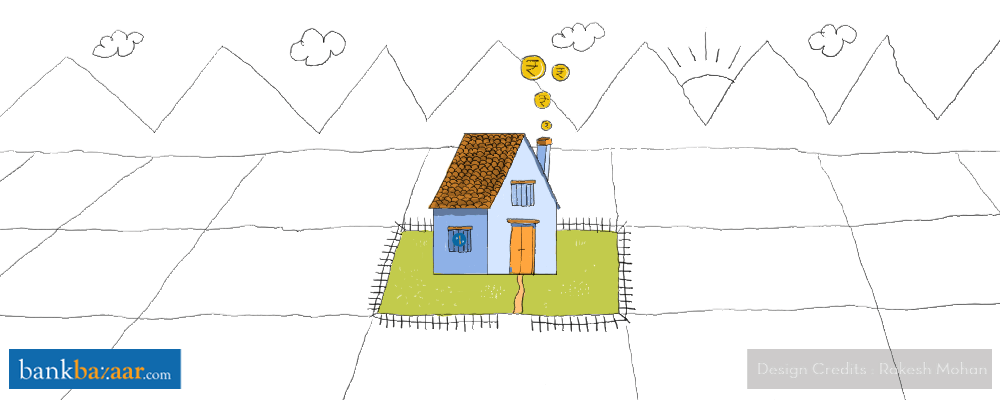
If you are a person who likes things customised to your taste, then a Composite Loan is the product for you. Keep in mind, however, that a Composite Loan is different from a regular Home Loan.
A Composite Loan is taken to purchase land and to meet the cost of construction of a house, which makes it perfect for anyone who prefers a garden and terrace of their own instead of an apartment with a balcony.
This was the case with Sahil, a software engineer from Bangalore. Sahil wanted to construct a house of his own rather buy a regular apartment. He found a plot that would cost him Rs. 30 lakhs, while the construction of a house on it would set him back by another Rs. 20 lakhs. Sahil had already saved Rs. 15 lakhs over the years and took a Composite Loan of Rs. 35 lakhs to cover the deficit.
Intrigued? Well, here’s how Composite Loans work:
Composite Loan a.k.a Plot-Plus-Construction Loan
A Composite Loan, also known as Plot-Plus-Construction Loan, is a type of Home Loan offered to individuals who are looking to purchase a plot with the purpose of building a house on it within the next few years. This kind of loan is disbursed in various instalments, commonly known as tranches.
The first tranche is disbursed for the purchase of the plot, while the rest of the tranches (usually three) are released as the construction of the house progresses. Once you decide on the plot you want to buy, you can approach a bank or lender for a Composite Loan.
Additional Reading: A 9-Point Checklist To Buying Land/Plot In India
Understanding the tranche system
When applying for a Composite Loan, you need to let the bank know how you intend to divide the funds between the costs of purchasing a plot and constructing a house. This information will determine the quantum of loan disbursed to you at various stages of the construction. The amount required to purchase the plot will be credited to your account first while the funds needed for construction will follow in tranches.
In Sahil’s case, he intended to use Rs. 20 lakhs to purchase the plot and Rs. 15 lakhs for the construction of his house. The banks initially disbursed Rs. 20 lakhs for the purchase of the plot, plus Rs. 5 lakhs for construction. The remaining two tranches of Rs. 5 lakhs each were disbursed to Sahil at varying stages of construction. Keep in mind though, that the tranche system may vary from one bank to another.
Additional Reading: 6 Options You May Not Think of While Taking a Home Loan
Banks usually closely monitor the construction progress to ensure that the money isn’t being used for any other purpose. In the case of Sahil, the first tranche was released to purchase the plot and to start the construction process. The second tranche was released upon the completion of 30% of construction and the final tranche was released when construction was 80% complete.
The borrower is required to submit a certificate of construction completion (attested by the architect/CA) in order to apply for the release of the next loan tranche. Banks reserve the right to cross-verify the same through their valuation agency, who may visit the site to verify the same.
Additional Reading: Home loan EMI essentials and types!
Repayment, interest rate, and loan tenure
In the case of a Composite Loan, the loan is deemed to be fully disbursed upon the receipt of the last tranche. The borrower is required to pay only pre-EMIs until the complete amount is disbursed. Your bank will have to disburse the complete amount within 2-3 years of sanctioning the loan. However, banks reserve the right with regards to disbursement of a loan in various tranches.
The interest rates on Composite Loans may also vary from bank to bank. Also, if the construction isn’t completed within the estimated time, you may have to pay extra interest or the bank may even recall the loan.
The tenure for a Composite Loan usually ranges anywhere from 1 to 20 years. The term doesn’t extend beyond the retirement age or 60 years, whichever is earlier, but the tenure can extend up to 65 years for a self-employed individual.
Additional Reading: The Dos And Don’ts For Home Loan Prepayment
Income Tax Benefits
You can claim tax sops on a Composite Loan as long as you finish the construction of your house within three years of purchase of the plot.
Loan Amount:
Banks generally fund 50% to 80% of the market value of the plot. The amount varies from bank to bank and it depends on the following factors:
- a) Repayment capacity of the borrower
b) Location of the property (within or outside city limits)
c) Type of allotment (direct allotment by developer or resale)
d) Is the land project approved by that particular bank or financial institution?
e) Age of the borrower
f) Sources of income (rental income, interest on investments)
When banks issue a Composite Loan, they always consider both the market value as well as the cost of the property as per the sale deed/ builder allotment papers etc. The market value of the property is provided to the lender by the architect. Apart from the regular property documents (as required in with a Home Loan), lenders ask for the cost estimate for construction of the property. In Sahil’s case, the banks asked for:
- a) Copy of all certificates issued to the developer by the government urban-planning authority (PUDA/ GMUDA)
b) Original property related documents issued by the developer to him i.e. allotment letter (stating plot number is mandatory to ensure proper demarcation of property), possession certificate, a copy of sanction plan of property (if any) etc.
Additional Reading: Home Loan Handbook: All Questions Answered
Composite Loan policy rules
When you apply for a Composite Loan it is assumed that the loan is taken for a house that will be self-occupied. The construction should cover at least 25% of the plot area and should qualify as a dwelling unit. The structure or a part of the structure of the residence should be occupied by one person or by two or more persons who maintain a common household.
While the bank will guide along the way once you take out a loan, in the general the process entails the following:
- a) The borrower has to provide the cost estimate for construction of the dwelling unit at the time of taking up the loan.
b) The estimate provided, should be certified by an architect or a chartered accountant
c) For a construction loan, the bank can fund anywhere between 70% – 90% of the construction estimate. The maximum loan-to-value ratio should not exceed 80% (this limit varies as per the internal policy of the lender)
Additional Reading: Insurance Protection For Home Loans
If purchasing a plot and constructing your own home is not your cup of tea, you can apply for a regular Home Loan. We have a host of them on offer.
